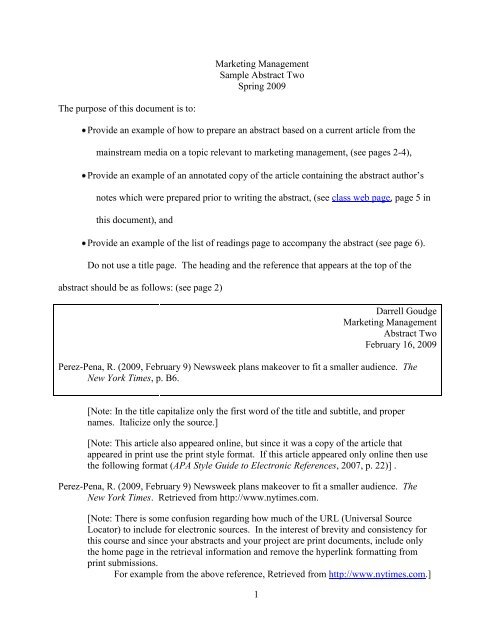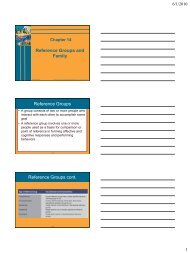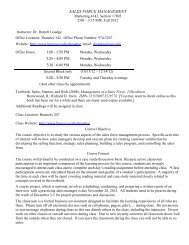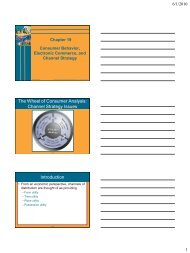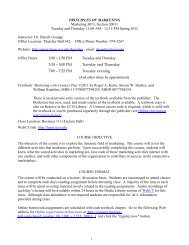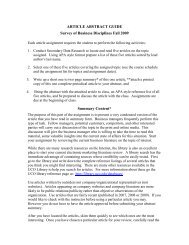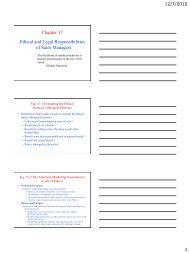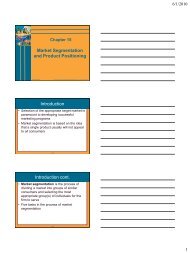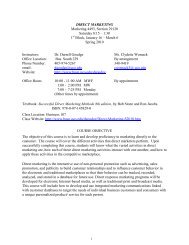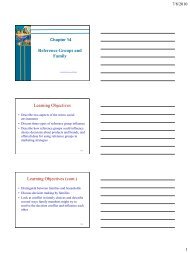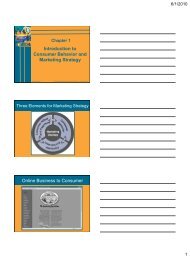Sample Abstract Two of New York Times article about Newsweek
Sample Abstract Two of New York Times article about Newsweek
Sample Abstract Two of New York Times article about Newsweek
Create successful ePaper yourself
Turn your PDF publications into a flip-book with our unique Google optimized e-Paper software.
Marketing Management<strong>Sample</strong> <strong>Abstract</strong> <strong>Two</strong>Spring 2009The purpose <strong>of</strong> this document is to:Provide an example <strong>of</strong> how to prepare an abstract based on a current <strong>article</strong> from themainstream media on a topic relevant to marketing management, (see pages 2-4),Provide an example <strong>of</strong> an annotated copy <strong>of</strong> the <strong>article</strong> containing the abstract author’snotes which were prepared prior to writing the abstract, (see class web page, page 5 inthis document), andProvide an example <strong>of</strong> the list <strong>of</strong> readings page to accompany the abstract (see page 6).Do not use a title page. The heading and the reference that appears at the top <strong>of</strong> theabstract should be as follows: (see page 2)Darrell GoudgeMarketing Management<strong>Abstract</strong> <strong>Two</strong>February 16, 2009Perez-Pena, R. (2009, February 9) <strong>New</strong>sweek plans makeover to fit a smaller audience. The<strong>New</strong> <strong>York</strong> <strong>Times</strong>, p. B6.[Note: In the title capitalize only the first word <strong>of</strong> the title and subtitle, and propernames. Italicize only the source.][Note: This <strong>article</strong> also appeared online, but since it was a copy <strong>of</strong> the <strong>article</strong> thatappeared in print use the print style format. If this <strong>article</strong> appeared only online then usethe following format (APA Style Guide to Electronic References, 2007, p. 22)] .Perez-Pena, R. (2009, February 9) <strong>New</strong>sweek plans makeover to fit a smaller audience. The<strong>New</strong> <strong>York</strong> <strong>Times</strong>. Retrieved from http://www.nytimes.com.[Note: There is some confusion regarding how much <strong>of</strong> the URL (Universal SourceLocator) to include for electronic sources. In the interest <strong>of</strong> brevity and consistency forthis course and since your abstracts and your project are print documents, include onlythe home page in the retrieval information and remove the hyperlink formatting fromprint submissions.For example from the above reference, Retrieved from http://www.nytimes.com.]1
2Darrell GoudgeMarketing Management<strong>Abstract</strong> <strong>Two</strong>February 16, 2009Perez-Pena, R. (2009, February 9) <strong>New</strong>sweek plans makeover to fit a smaller audience. The<strong>New</strong> <strong>York</strong> <strong>Times</strong>, p. B6.The main topic <strong>of</strong> this <strong>article</strong> is the challenges facing <strong>New</strong>sweek magazine in the currentmarketplace and how its marketing management team plans to react to these challenges. Theweekly “news magazine” market has undergone substantial changes since its inception manydecades ago, with increased competition that new media forms like the Internet provide, how thereading habits <strong>of</strong> its traditional readers are changing, and the shrinking market for <strong>New</strong>sweek’scurrent product. <strong>New</strong>sweek has been losing money and the downturn <strong>of</strong> the economy is placingmore pressure on <strong>New</strong>sweek to make changes. <strong>New</strong>sweek plans to become pr<strong>of</strong>itable again bychanging its marketing strategy, target market, and marketing tactics (marketing mix).<strong>New</strong>s magazines, at the beginning <strong>of</strong> their product life cycle over a century ago, havetraditionally positioned themselves as providing up-to-date news services for their subscribers.Although these magazines provided less frequent coverage than their newspaper counterparts,they differentiated their services by providing a more detailed analysis <strong>of</strong> that news. In addition,<strong>New</strong>sweek positioned itself, as the brand name implies, as providing weekly news. Circulationand advertising revenues have dropped substantially in this market. <strong>New</strong>sweek’s competitorshave varying levels <strong>of</strong> success. Time magazine, which has the largest share <strong>of</strong> the market, is stillpr<strong>of</strong>itable, but another competitor, U. S. <strong>New</strong>s and World Report has reduced its publicationfrequency from weekly to monthly issues.<strong>New</strong>sweek’s research showed that a large portion <strong>of</strong> its customer base was the leastpr<strong>of</strong>itable segment because those that were paying the least for the magazine had the highest persubscriber marketing costs. <strong>New</strong>sweek, which traditionally served a mass market, now plans to
with fewer magazines to print, will return them to pr<strong>of</strong>itability by increasing their total revenuesand lowering their total costs <strong>of</strong> production, distribution, and marketing. Media experts agreethat these changes might work, but in the current economic climate that this is a high riskstrategy.This <strong>article</strong> is related to the material we covered on situational analysis in Chapter onepp. 4-5, the target market, pp. 5-6, and marketing strategy pp. 6-7, and marketing tactics, p. 7.This <strong>article</strong> is also related to the material we covered in Chapter two the product life cycle, pp.10-11, market segmentation and target marketing pp. 16-20, and Chapter three establishingobjectives pp. 26-28 and differential advantage pp. 29-31.4
[Attach copy <strong>of</strong> <strong>article</strong> abstracted here]5
List <strong>of</strong> Articles Read[Include all five <strong>article</strong>s you read for this assignment on the last page. Here is an example <strong>of</strong> thelist <strong>of</strong> <strong>article</strong>s read page.]Baker, M. (2004, November 22) The online ad surge. Business Week, pp. 76-82.Lowry, T. (2009 n.d.) Google TV: Still a tough sell: As Google pulls out <strong>of</strong> the newspaper andradio ad business, it seems loyal to its TV efforts, but several shortcomings are holding itback [Online Exclusive]. Businessweek Online. Retrieved February 13, 2009, fromwww.businessweek.comManning, J. and Keller, K. L. (2004, January/February) Got advertising that works? MarketingManagement, pp. 16-20.Perez-Pena, R. (2009, February 9) <strong>New</strong>sweek plans makeover to fit a smaller audience. The<strong>New</strong> <strong>York</strong> <strong>Times</strong>, p. B6.Peterson, J. (2006, June 4) A new age for the ad biz. Los Angeles <strong>Times</strong>, pp. C1, C11.[Note: The Lowry, T. online reference format above is based on the example from the APA StyleGuide to Electronic References, 2007, p. 22. (see below)]45. Online magazine content not found in print versionGutierrez, D. (n.d.). On state political torture [Online exclusive]. Tikkun. RetrievedJanuary 28, 2007, from http://www.tikkun.org/magazine/specials/statetorture6


